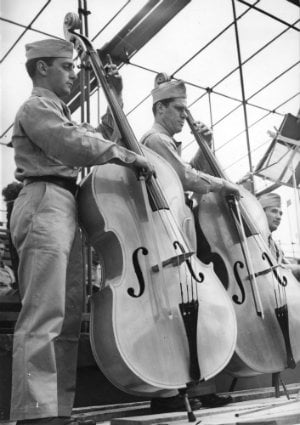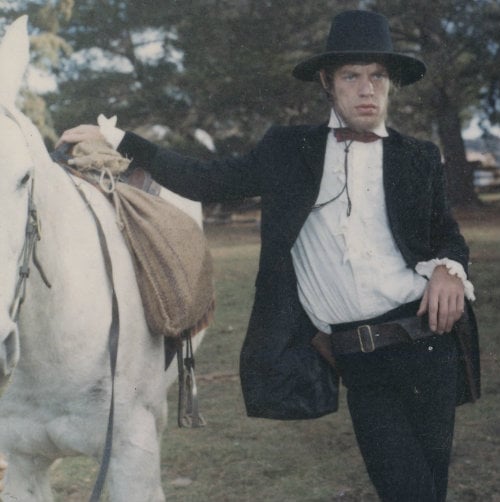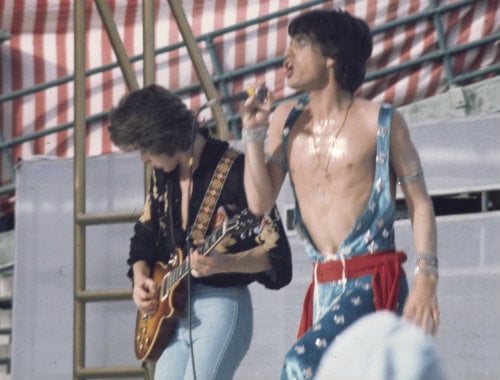In the wake of the 2018 Australian Tennis Open it is an opportune time to reflect on the former home of the Open, the Kooyong Tennis Stadium, particularly the stadium’s brief and successful foray into music.
Some of Kooyong’s greatest hits weren’t from the racquets of John Newcombe or Billie Jean King but from that select group of the world’s greatest rock stars whose performances at the stadium were as incendiary as a McEnroe meltdown, as graceful as a Goolagong backhand, as rock steady as the Borg baseline game.
The land for the Kooyong tennis courts was purchased in 1919[i]. It was bordered by the railway line, Glenferrie Road and Gardiners Creek. The latter’s propensity to flood provided headaches over many years for the tennis courts and the adjacent St Kevin’s College and Scotch College.
The concrete stadium and clubhouse were completed in time to host the first Australian Tennis Championships in 1927[ii] (prior to that it was the Australasian Championships, first held in 1905[iii]).
During the Second World War the Championship was suspended and Kooyong hosted concerts by the Melbourne Symphony Orchestra (not always successfully) and the United States Services Military Band [iv].
Recomencing in 1946 the Australian Tennis Championships alternated between Sydney, Adelaide, Brisbane and the Kooyong courts in Melbourne until 1971, when Kooyong became their permanent home.[v]
This permanent move to Kooyong coincided with the stadium’s use as a venue for a select number of lucrative rock concerts, beginning with Elton John in 1971.
In 1972 behemoths of rock, Led Zeppelin, played a riotous concert. In January 1973 it was the progenitors of heavy metal Black Sabbath.
Then, on a hot weekend in February 1973, the Rolling Stones, billed as the world’s greatest rock band, played three stellar shows.
The Rolling Stones were returning to Australia for their first visit since 1966. In the interim they had released four albums that still, all this time later, form the heart of their live sets[vi]. They had survived infamous police raids and the subsequent (brief) imprisonment of Keith Richards and Mick Jagger. [vii]
In 1969 an increasingly fragile and debilitated Brian Jones drowned in his swimming pool. Jones had become disillusioned as the band moved away from purist blues. His slow decline had affected the band’s capacity to perform live and he had long since been superceded as leader by Jagger and Richards. Shortly before his death he had parted from the band.[viii]
Towards the end of 1969, with a new guitarist, 20 year old prodigy Mick Taylor, the band embarked on an American tour that included the notorious Altamont concert and resulted in one of the great music documentaries and a great live album[ix].
Australia was not on the itinerary, however earlier that year Mick Jagger and then partner Marianne Faithfull were in Australia for Mick’s turn as Ned Kelly[x]. This garnered much local hostility, and to add to the drama Marianne ended up in hospital after a drug overdose[xi].
The anticipation for the 1973 concerts was intense and the performance lived up to the hype. Kooyong Tennis stadium was a bigger venue than their last tour where they played at the Palais but it was ideal for concerts, and certainly far superior to watching ants on stage from the depths of the MCG when the band next returned in 1995.
The three concerts were performed on the afternoon and evening of Saturday 17 and Sunday the 18th of February 1973 [xii]. While the audience felt they had been privileged to attend one of the great rock performances, the local residents of Melbourne’s wealthiest suburb were not impressed. Rock music didn’t return to Kooyong until Midnight Oil and Hunters and Collectors played there in 1985. In 1986 it was Bob Dylan and Tom Petty, and then Dolly Parton and Kenny Rogers, followed in 1987 by Billy Joel. In 1987 another great music icon David Bowie performed four concerts as part of his Glass Spider Tour. This was a fitting finale for Kooyong’s life as a rock music venue.
As music left the venue so did the Australian Open.
It had become increasingly difficult to attract the world’s best players to the event, and the global sport demanded more modern facilities than Kooyong could provide. In 1987 the final Australian Open on the grass at Kooyong was won by Stefan Edberg (men) and Hannah Mandilikova (women). In 1988 the championship moved to the synthetic court surfaces of the new National Tennis Centre adjacent to the MCG.
The septuagenarian Stones, remarkably, are still rolling, however never again have they neared the pinnacle reached on that hot February weekend 45 years ago.
Further reading
A serve to authority : Kooyong: 100 years of heroes & headlines by Richard Yallop
We hold an extensive collection of books on popular music including the Rolling Stones, Led Zeppelin, Black Sabbath, David Bowie and other musicians mentioned in this post.
Notes
[i] Lawn tennis The Australasian 27 December 1919: p. 21
[ii] Lawn tennis The Australasian, 29 January1927, p. 39.
[iii]Lawn tennis. The Herald, 25 November 1905, p. 6.
[iv]Amusements The Age 4 January 1943: p.5.The MSO arranged a number of concerts but on this occasion were thwarted by the weather. The US Services Military Band had a more successful time Amusements The Age 22 February 1943: p.3.
[v] Confusingly the 1971 Australian Open was played at White City Sydney in March 1971, while the 1972 Open began on 27 December 1971 at Kooyong
[vi] The four albums, Beggars Banquet (1968), Let it Bleed (1969), Sticky Fingers (1971) and Exile on Main Street (1972) find their way to high positions in most lists of rock’s best albums and are generally considered the Rolling Stones finest.
[vii] Even the establishment sided with the incarcerated musicians. The conservative London Times defended Mick Jagger with the famous ‘Butterfly on a wheel’ editorial. (This link available online to registered Victorian users).
[viii] Jones of the Stones dies The Age 4 July 1969, p.5. See also these books.
[ix] The Mayles brothers documentary Gimme Shelter and the cracking live record of the tour, ‘Get Yer Ya-Ya’s Out!’
[x] It’s Mick (Ned Kelly) Jagger The Australian Women’s Weekly (1933 – 1982) 23 July 1969: p.18
[xi] Singer in nuns’ care The Canberra Times 18 July 1969: p.3.
[xii] Jagger: sexuality, innocence, exhibitionismThe Age 19 February 1973: p.2.






Such a fun and intersting read… thank you
Well researched and very well written article…I can feel the nostalgia!